NCERT Solutions Class 12 Chemistry Chapter 7 - Alcohols, Phenols & Ethers
Page No. 195 - Intext Questions
Q7.1: Classify the following as primary, secondary and tertiary alcohols:
Ans: Primary alcohol → (i), (ii), (iii)
Secondary alcohol → (iv), (v)
Tertiary alcohol → (vi)
Q7.2: Identify allylic alcohols in the above examples.
Ans: The alcohols given in (ii) and (vi) are allylic alcohols.
Page No. 198 - Intext Questions
Q7.3: Name the following compounds according to IUPAC system.
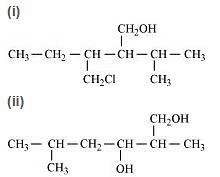

Ans: (i) 3-Chloromethyl-2-isopropylpentan-1-ol
(ii) 2, 5-Dimethylhexane-1, 3-diol
(iii) 3-Bromocyclohexanol
(iv) Hex-1-en-3-ol
(v) 2-Bromo-3-methylbut-2-en-1-ol
Page No. 203 - Intext Questions
Q7.4: Show how are the following alcohols prepared by the reaction of a suitable Grignard's reagent on methanal?

Ans:

(ii)

Q7.5: Write structures of the products of the following reactions:

Ans: (i)

(ii)

(iii)

Page No. 213 - Intext Questions
Q7.6: Give structures of the products you would expect when each of the following alcohol reacts with (a) HCl-ZnCl2 (b) HBr and (c) SOCl2.
(i) Butan-1-ol (ii) 2-Methylbutan-2-ol
Ans:
(a)
(i)

Primary alcohols do not react appreciably with Lucas’ reagent (HCl-ZnCl2) at room temperature.
(ii)

Tertiary alcohols react immediately with Lucas’ reagent.
(b)
(i)

(ii)

(c)
(i)

(ii)

Q7.7: Predict the major product of acid catalysed dehydration of
(i) 1-methyl cyclohexanol and
(ii) butan-1-ol
Ans:
(i)

(ii)

Q7.8: Ortho and para nitrophenols are more acidic than phenol. Draw the resonance structures of the corresponding phenoxide ions.
Ans: The resonance structures of o-and p- nitrophenoxide ions and phenoxide ion are given below:


Q7.9: Write the equations involved in the following reactions:
(i) Reimer-Tiemann reaction
(ii) Kolbe’s reaction
Ans: Reimer-Tiemann reaction
Kolbe’s reaction

Page No. 220 - Intext Questions
Q7.10: Write the reactions of Williamson synthesis of 2-ethoxy-3-methyl pentane starting from ethanol and 3-methylpentan-2-ol.
Ans: In Williamson synthesis, an alkyl halide reacts with an alkoxide ion. Also, it is an SN2 reaction. In the reaction, alkyl halides should be primary having the least steric hindrance. Hence, an alkyl halide is obtained from ethanol and alkoxide ion from 3-methylpentan-2-ol.



Q7.11: Which of the following is an appropriate set of reactants for the preparation of 1-methoxy-4-nitrobenzene and why?
(i)

(ii)

Ans: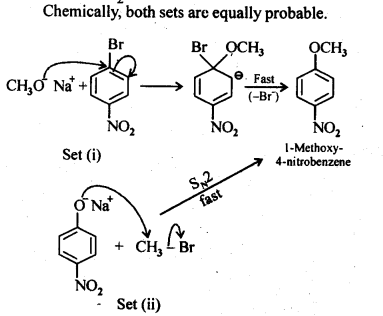
Page No. 221 - Intext Questions
Q7.12: Predict the products of the following reactions:
(i)

(ii)

(iii)

(iv)

Ans:
(i)

(ii)

(iii)

(iv)

NCERT Exercises
Q7.1: Write IUPAC names of the following compounds:Ans: (i) 2, 2, 4-Trimethylpentan-3-ol
(ii) 5-Ethylheptane-2, 4-diol
(iii) Butane-2, 3-diol
(iv) Propane-1, 2, 3-triol
(v) 2-Methylphenol
(vi) 4-Methylphenol
(vii) 2, 5-Dimethylphenol
(viii) 2, 6-Dimethylphenol
(ix) 1-Methoxy-2-methylpropane
(x) Ethoxybenzene
(xi) 1-Phenoxyheptane
(xii) 2-Ethoxybutane
Q7.2: Write structures of the compounds whose IUPAC names are as follows:
(i) 2-Methylbutan-2-ol
(ii) 1-Phenylpropan-2-ol
(iii) 3,5-Dimethylhexane −1, 3, 5-triol
(iv) 2,3 − Diethylphenol
(v) 1 – Ethoxypropane
(vi) 2-Ethoxy-3-methylpentane
(vii) Cyclohexylmethanol
(viii) 3-Cyclohexylpentan-3-ol
(ix) Cyclopent-3-en-1-ol
(x) 3-Chloromethylpentan-1-ol.
Ans:
Q7.3: (i) Draw the structures of all isomeric alcohols of molecular formula C5H12O and give their IUPAC names.
(ii) Classify the isomers of alcohols in question 11.3 (i) as primary, secondary and tertiary alcohols.
Ans:
(i) The structures of all isomeric alcohols of molecular formula, C5H12O are shown below:

(ii) Praimary: (i), (ii), (iii), (iv)
Secondary :(v), (vi), (viii)
Tertiary : (vii)
Q7.4: Explain why propanol has higher boiling point than that of hydrocarbon, butane?
Ans: The molecules of butane are held together by weak van der Waal’s forces of attraction while those of propanol are held together by stronger intermolecular hydrogen bonding.

Therefore, extra energy is required to break hydrogen bonds. For this reason, propanol has a higher boiling point than hydrocarbon butane.
Q7.5: Alcohols are comparatively more soluble in water than hydrocarbons of comparable molecular masses. Explain this fact.
Ans: Alcohols form H-bonds with water due to the presence of −OH group. However, hydrocarbons cannot form H-bonds with water.

As a result, alcohols are comparatively more soluble in water than hydrocarbons of comparable molecular masses.
Q7.6: What is meant by the hydroboration-oxidation reaction? Illustrate it with an example.
Ans: The addition of diborane to alkenes to form trialkyl boranes followed by their oxidation with alkaline hydrogen peroxide to form alcohols is called hydroboration-oxidation. For example,

Q7.7: Give the structures and IUPAC names of monohydric phenols of molecular formula, C7H8O.
Ans:
Q7.8: While separating a mixture of ortho and para nitrophenols by steam distillation, name the isomer which will be steam volatile. Give reason.
Ans: o-nitrophenol is steam volatile due to chelation (intramolecular H – bonding) and hence can be separated by steam distillation from/Miitrophenol which is hot steam volatile because of intermolecular H-bonding.

Q7.9: Give the equations of reactions for the preparation of phenol from cumene.
Ans: This process has great industrial importance because it gives the preparation of two very useful compounds i.e. phenol and acetone. The raw materials are benzene and propene and it initially proceeds by Friedel Crafts alkylation of benzene.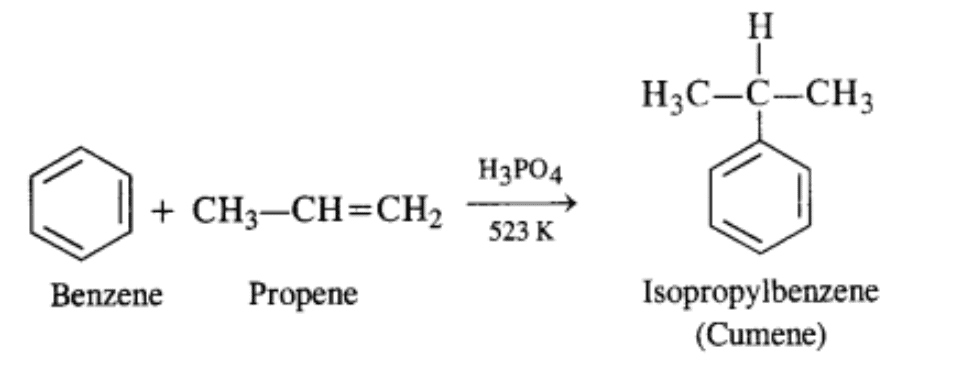
Oxygen is bubbled through the above solution to form cumene hydroperoxide which is decomposed with aqueous acid in the solution to form phenol and acetone as follows:
Q7.10: Write a chemical reaction for the preparation of phenol from chlorobenzene.
Ans: Chlorobenzene is fused with NaOH (at 623 K and 320 atm pressure) to produce sodium phenoxide, which gives phenol on acidification. 
Q7.11: Write the mechanism of hydration of ethene to yield ethanol.
Ans: Direct addition of H20 to ethene in the presence of an acid does not occur. Indirectly, ethene is first passed through concentrated H2S04, when ethyl hydrogen sulfate is formed.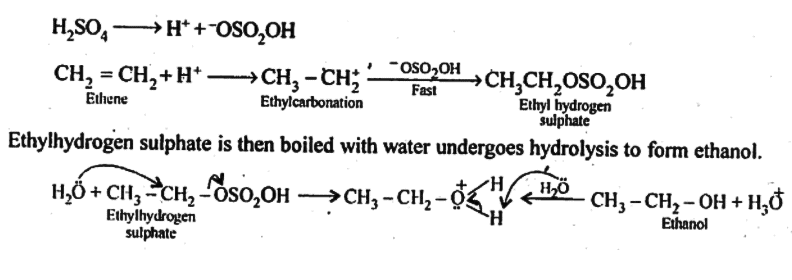
Q7.12: You are given benzene, conc. H2SO4 and NaOH. Write the equations for the preparation of phenol using these reagents.
Ans:
Q7.13: Show how will you synthesize:
(i) 1-phenylethanol from a suitable alkene.
(ii) cyclohexylmethanol using an alkyl halide by an SN2 reaction.
(iii) pentan-1-ol using a suitable alkyl halide?
Ans: (i) By acid-catalyzed hydration of ethylbenzene (styrene), 1-phenylethanol can be synthesized.
(ii) When chloromethylcyclohexane is treated with sodium hydroxide, cyclohexyl methanol is obtained.
(iii) When 1-chloropentane is treated with NaOH, pentan-1-ol is produced.
Q7.14: Give two reactions that show the acidic nature of phenol. Compare the acidity of phenol with that of ethanol.
Ans: The acidic nature of phenol can be represented by the following two reactions:
(i) Phenol reacts with sodium to give sodium phenoxide, liberating H2.
(ii) Phenol reacts with sodium hydroxide to give sodium phenoxide and water as by-products.
The acidity of phenol is more than that of ethanol. This is because after losing a proton, the phenoxide ion undergoes resonance and gets stabilized whereas the ethoxide ion does not.
Q7.15: Explain why is ortho nitrophenol more acidic than ortho methoxy phenol?
Ans:
Nitro (NO2) group is an electron-withdrawing group while methoxy (OCH3) group is electron-releasing in nature. The release of H+ ion is therefore, easier from o-nitrophenol while it is quite difficult from o-methoxyphenol. Apart form that, o-nitrophenoxide ion is stabilised due to resonance o-nitrophenol is steam volatile while p-nitrophenol is not. This is on account of intramolecular hydrogen bonding in the molecules of o-nitrophenol. As a result, its boiling point is less than that of p-nitrophenol in which the molecules are linked by intermolecular hydrogen bonding.
It is interesting to note that in the substituted phenols, the nature and position of the substituent influence the boiling point of phenol.
For example: .o-nitrophenol is steam volatile while p-nitrophenol is not. This is supported by the fact that the boiling point temperature of o-nitrophenol (100°C) is less than that of p-nitrophenol, (279°C). In o-nitrophenol, there is intramolecular hydrogen bonding in OH and NO2 groups placed in a adjacent positions. However, these are linked by intermolecular hydrogen bonding in the p-isomers. It is quite obvious that extra energy is needed to the cleave the hydrogen bonds in the p-isomer. Consequently, its boiling point is more. o-nitrophenol with a lower boiling point is steam volatile while p-nitrophenol is not. This helps in the separation of the two isomers present in the liquid mixture. On passing steam, o-nitrophenol volatilises and its vapors rise along with steam and after condensation, collect in the receiver p-nitrophenol is left behind in the distillation flask. e-nkrophenol p-nnrophenol.
o-nitrophenol with a lower boiling point is steam volatile while p-nitrophenol is not. This helps in the separation of the two isomers present in the liquid mixture. On passing steam, o-nitrophenol volatilises and its vapors rise along with steam and after condensation, collect in the receiver p-nitrophenol is left behind in the distillation flask. e-nkrophenol p-nnrophenol.
On the contrary, o-methoxyphenoxide is destabilized since the electron density on the negatively charged oxygen tends to increase due to the electron-releasing tendency of the methoxy(OCH3) group.
In the light of the above discussion, we may conclude that o-nitrophenol is a stronger acid (pKa = 7-23) than o-methoxyphenyl (pKa = 9.98)
Q7.16: Explain how does the −OH group attached to a carbon of benzene ring activate it towards electrophilic substitution?
Ans: Phenol may be regarded as a resonance hybrid of structures I-V, shown below.

As a result of +R effect of the -OH group, the electron density in the benzene ring increases thereby facilitating the attack of an electrophile. In other words, the presence of -OH group, activates the benzene ring toward electrophilic substitution reactions. Further, since the electron density is relatively higher at the two o-and one p-position, therefore electrophilic substitution occurs mainly at o-and p-positions.
Q7.17: Give equations of the following reactions:
(i) Oxidation of propan-1-ol with alkaline KMnO4 solution.
(ii) Bromine in CS2 with phenol.
(iii) Dilute HNO3 with phenol.
(iv) Treating phenol with chloroform in presence of aqueous NaOH.
Ans:
Q7.18: Explain the following with an example.
(i) Kolbe’s reaction.
(ii) Reimer-Tiemann reaction.
(iii) Williamson ether synthesis.
(iv) Unsymmetrical ether.
Ans: (i) Kolbe’s reaction:
When phenol is treated with sodium hydroxide, sodium phenoxide is produced. This sodium phenoxide when treated with carbon dioxide, followed by acidification, undergoes electrophilic substitution to give ortho-hydroxybenzoic acid as the main product. This reaction is known as Kolbe’s reaction.
(ii) Reimer-Tiemann reaction:
When phenol is treated with chloroform (CHCl3) in the presence of sodium hydroxide, a −CHO group is introduced at the ortho position of the benzene ring.
This reaction is known as the Reimer-Tiemann reaction.
The intermediate is hydrolyzed in the presence of alkalis to produce salicylaldehyde.
(iii) Williamson ether synthesis:
It involves the treatment of an alkyl halide with a suitable sodium alkoxide to obtain ethers. The sodium alkoxide needed for the purpose is prepared by the action of sodium on a suitable alcohol. In this reaction, alkyl halide should be primary. Secondary and tertiary halides will predominantly give an alkene.
(iv) Unsymmetrical ether:
An unsymmetrical ether is an ether where two groups on the two sides of an oxygen atom differ (i.e., have an unequal number of carbon atoms). For example, ethyl methyl ether, methyl phenyl ether, 4-chlorophenyl- 4-nitrophenyl ether, etc.
Q 7.19: Write the mechanism of acid-catalyzed dehydration of ethanol to yield ethene.
Ans: The mechanism of acid dehydration of ethanol to yield ethene involves the following three steps:
Step 1:
Protonation of ethanol to form ethyl oxonium ion:
Step 2:
Formation of carbocation (rate-determining step):
Step 3:
Elimination of a proton to form ethene:
The acid consumed in step 1 is released in Step 3. After the formation of ethene, it is removed to shift the equilibrium in a forward direction.
Q7.20: How are the following conversions carried out?
(i) Propene → Propan-2-ol
(ii) Benzyl chloride → Benzyl alcohol
(iii) Ethyl magnesium chloride → Propan-1-ol.
(iv) Methyl magnesium bromide → 2-Methylpropan-2-ol.
Ans: (i) 
(ii)

(iii)

(iv)

Q7.21: Name the reagents used in the following reactions:
(i) Oxidation of primary alcohol to carboxylic acid.
(ii) Oxidation of primary alcohol to aldehyde.
(iii) Bromination of phenol to 2,4,6-tribromophenol.
(iv) Benzyl alcohol to benzoic acid.
(v) Dehydration of propan-2-ol to propene.
(vi) Butan-2-one to butan-2-ol.
Ans: (i) Acidified potassium dichromate or neutral/ acidic/ alkaline potassium permanganate.
(ii) Pyridinium chlorochromate (PCC) or Pyridinium dichromate (PDC)
(iii) Aqueous bromine,
(iv) Acidified potassium permanganate
(v) 85% H2S04 at 440 K.
(vi) Ni/H2 or NaBH4 or LiAlH4.
Q7.22: Give a reason for the higher boiling point of ethanol in comparison to methoxymethane.
Ans: Ethanol undergoes intermolecular H-bonding due to the presence of the −OH group, resulting in the association of molecules. Extra energy is required to break these hydrogen bonds. On the other hand, methoxymethane does not undergo H-bonding. Hence, the boiling point of ethanol is higher than that of methoxymethane.

Q7.23: Give IUPAC names of the following ethers:
Ans: (i) 1-Ethoxy-2-methylpropane
(ii) 2-Chloro-1-methoxyethane
(iii) 4-Nitroanisole
(iv) 1-Methoxypropane
(v) 1-Ethoxy-4, 4-dimethylcyclohexane
(vi) Ethoxybenzene
Q7.24: Write the names of reagents and equations for the preparation of the following ethers by Williamson’s synthesis:
(i) 1-Propoxypropane
(ii) Ethoxybenzene
(iii) 2-Methoxy-2-methylpropane
(iv) 1-Methoxyethane
Ans:
(i)

(ii)

(iii)

(iv)
Q7.25: Illustrate with examples the limitations of Williamson synthesis for the preparation of certain types of ethers.
Ans: Williamson’s synthesis is a versatile method for the synthesis of both symmetrical and unsymmetrical ethers. However, for the synthesis of unsymmetrical ethers, a proper choice of reactants is necessary. Since Williamson’s synthesis occurs by SN2 mechanism and primary alkyl halides are most reactive in Sn2 reaction, therefore, best yields of unsymmetrical ethers are obtained when the alkyl halides are primary and the alkoxide may be primary, secondary, or tertiary. For example, tert-butylethyl ether is prepared by treating ethyl bromide with sodium tert-butoxide. The above ether cannot be prepared by treating sodium ethoxide with tert-butyl chloride or bromide since under these conditions an alkene, i.e., isobutylene is the main product
The above ether cannot be prepared by treating sodium ethoxide with tert-butyl chloride or bromide since under these conditions an alkene, i.e., isobutylene is the main product Aryl and vinyl halides cannot be used as substrates because they are less reactive in nucleophilic substitution.
Aryl and vinyl halides cannot be used as substrates because they are less reactive in nucleophilic substitution.
Q7.26: How is 1-propoxypropane synthesized from propan-1-ol? Write mechanism of this reaction.
Ans: 1-propoxypropane can be synthesized from propan-1-ol by dehydration.
Propan-1-ol undergoes dehydration in the presence of protic acids (such as H2SO4, H3PO4) to give 1-propoxypropane.
The mechanism of this reaction involves the following three steps:
Step 1: Protonation
Step 2: Nucleophilic attack
Step 3: Deprotonation
Q7.27: Preparation of ethers by acid dehydration of secondary or tertiary alcohols is not a suitable method. Give reason.
Ans: TAcid catalysed dehydration of primary alcohols to ethers occurs by SN2 reaction involving nucleophilic attack by the alcohol molecule on the protonated alcohol molecule. Under these conditions, 2° and 3° alcohols, however, give alkenes rather than ethers. The reason being that due to steric hindrance, nucleophilic attack by the alcohol molecule on the protonated alcohol molecule does not occur. Instead protonated 2° and 3° alcohols lose a molecule of water to form stable 2° and 3° carbocation. These carbocations prefer to lose a proton to form alkenes rather than undergoing nucleophilic attack by alcohol molecules to form ethers.
Under these conditions, 2° and 3° alcohols, however, give alkenes rather than ethers. The reason being that due to steric hindrance, nucleophilic attack by the alcohol molecule on the protonated alcohol molecule does not occur. Instead protonated 2° and 3° alcohols lose a molecule of water to form stable 2° and 3° carbocation. These carbocations prefer to lose a proton to form alkenes rather than undergoing nucleophilic attack by alcohol molecules to form ethers.
Q7.28: Write the equation of the reaction of hydrogen iodide with:
(i) 1-propoxypropane
(ii) Methoxybenzene and
(iii) Benzyl ethyl ether
Ans: (i)

(ii)
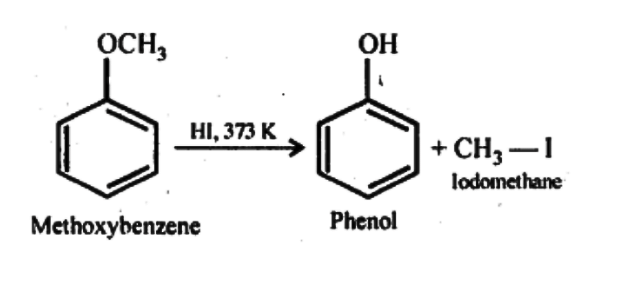
(iii)

Q7.29: Explain the fact that in aryl alkyl ethers
(i) The alkoxy group activates the benzene ring towards electrophilic substitution and
(ii) It directs the incoming substituents to ortho and para positions in the benzene ring.
Ans:
(i)
In aryl alkyl ethers, due to the R effect of the alkoxy group, the electron density in the benzene ring increases as shown in the following resonance structure.
Thus, benzene is activated towards electrophilic substitution by the alkoxy group. As the ortho and para positions in the ring become points of high electron density, the electrophiles prefer to attack these positions.
(ii) It can also be observed from the resonance structures that the electron density increases more at the ortho and para positions than at the meta position. As a result, the incoming substituents are directed to the ortho and para positions in the benzene ring.
Q7.30: Write the mechanism of the reaction of HI with methoxymethane.
Ans: The mechanism of the reaction of HI with methoxymethane involves the following steps: If however, excess of HI is used, methyl alcohol formed in step (b) is also converted into methyl iodide by following mechanism:
If however, excess of HI is used, methyl alcohol formed in step (b) is also converted into methyl iodide by following mechanism:

Q7.31: Write equations of the following reactions:
(i) Friedel-Crafts reaction−alkylation of anisole.
(ii) Nitration of anisole.
(iii) Bromination of anisole in ethanoic acid medium.
(iv) Friedel-Craft’s acetylation of anisole.
Ans: (i)
(ii)
(iii)
(iv)
Q7.32: Show how would you synthesise the following alcohols from appropriate alkenes?

Ans: All the alcohols are formed by the hydration of alkenes in the acidic medium. The addition follows Markownikov’s rule. 1-Methylcyclohexene can be used in the reaction.
(i)

(ii) 4-Methylpent-3-ene upon hydration in the acidic medium will give the desired alcohol.

(iii) Pent-2-ene gives the desired alcohol upon hydration in the presence of acid.

(iv) The cyclic alkene used in this reaction is 2-cyclohexylbut-2-ene.
Q7.33: When 3-methylbutan-2-ol is treated with HBr, the following reaction takes place:
Give a mechanism for this reaction.
(Hint: The secondary carbocation formed in step II rearranges to a more stable tertiary carbocation by a hydride ion shift from the 3rd carbon atom.
Ans: The mechanism of the given reaction involves the following steps:
Step 1: Protonation
Step 2: Formation of 2° carbocation by the elimination of a water molecule
Step 3: Re-arrangement by the hydride-ion shift
Step 4: Nucleophilic attack
|
75 videos|349 docs|78 tests
|
FAQs on NCERT Solutions Class 12 Chemistry Chapter 7 - Alcohols, Phenols & Ethers
| 1. What are the physical properties of alcohols, phenols, and ethers? |  |
| 2. How are alcohols, phenols, and ethers classified based on their structure? |  |
| 3. What are some common uses of alcohols, phenols, and ethers in daily life? |  |
| 4. How do alcohols, phenols, and ethers react with different reagents? |  |
| 5. What are some important industrial applications of alcohols, phenols, and ethers? |  |






















